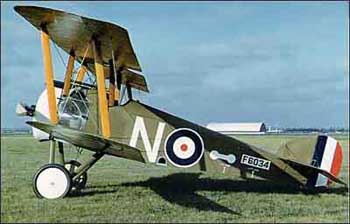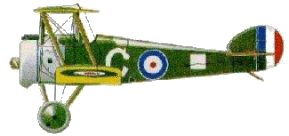|


The Sopwith Camel was credited with the
destruction of 1,294 enemy aircraft during World War I, thus claiming
the unique distinction of obtaining more air-to-air victories than any
other single type in that conflict.
Developed from the Pup, the Camel was utterly conventional for its
time, wings and fuselage comprising wire-braced wooden structures with
fabric covering. Standard engine was the Clerget 130 h.p. unit, but
some were equipped with 110-h.p. LeRhone powerplants. In large part,
the engine accounted for the Camel's unusual manoeuvrability, for
everything heavy—pilot, engine, fuel, armament--was in a compact area,
which tended not to impede the sharp torque of the rotaries. Right-hand
turns could thus be executed with extreme precision and rapidity. The
Camel could be spun very quickly and the elevator was extremely
sensitive. It was said some pilots, required to make a 90 degree left
turn, preferred turning 270 degrees rightward ....which seemed faster!
However, the Camel was thus a very tricky machine to handle, and could
kill careless pilots in a hurry.
Those who survived solo flights in Camels quickly became devotees, and
learned to use the aircraft's eccentricities to initiate or escape
situations as necessary. Like the Messerschmitt of a later era, cynics
of the period suggested that, once a pilot had learned to handle this
machine, it was difficult to fly a "normal" airplane.
The Camel's nickname came from the fairing over the two Vickers guns,
close mounted under the hump. These beltfed, late model Mk.I and II
llmm guns had a high rate of fire for the time, and their tight
mounting made them easier to aim.
Various of the eccentricities of the Camel, especially compared to the
relatively docile trainers of the period, prompted production of a
two-seat, dual-control training version.
The combat record of Sopwith's last major WWI fighter design is filled
with extraordinary fights.
Captain J.L. Trollope of Number 43 Squadron shot down six Germans in
one day-two D.F.W. two-seaters, an Albatross Scout, and three other
two-seaters just before afternoon tea.
Captain H.W. Woollett of No. 209 Squadron equaled the feat a few days
later, downing a Pfalz, a Fokker, and four other machines in a
twenty-four hour span.
The Camel had delivered Allied air superiority in the West by January
of 1918, and from then until the end of the war, they never surrendered
the advantage over any significant area, or for any major span of time.
On 21 April, 1918, the Camel was involved in the most famous and
debated victory of the war. Captain A.R. Brown led Number 209
Squadron's eight Camel patrol near the Somme, and joined a dogfight
between two Dr.I's and a pair of R.E.S's, in turn gaining the unwelcome
attention of a mixed flight of fifteen Dr.I's and Albatros D.Va's.
Brown tore off, diving after a red Fokker, pumping a quick burst into
it. Some debate who actually downed or killed von Richthofen, but what
is sure is that he died as a result of injuries sustained either in the
fight or the landing, some eighty victories to his credit. The Germans
had drawn considerable ground fire, and the battle was confused.
Naval Camels also performed brilliantly during the war. Almost all
R.N.A.S. Camels were powered by 150-h.p. Bentley rotary engines.
The Camel was subject of many unusual mission and experiments, and
accomplished many breakthroughs in aerial warfare technology...first
night victory (a Gotha over East London, 1/25/18), first specialized
carrier-gear equipped fighter, last Zeppelin shot down, but probably
the first over the open sea, first extensive dive-bombing testing, and
the first airship use of a "parasite" fighter. Even a specialized night
fighter version was evolved and delivered, equipped usually with
LeRhone engines, damped exhaust, lighted panel, etc.
The 5,490 Camels built served in the British, Canadian, American,
Belgian, Greek, and associated air forces during the war, and many
others afterward. They served worldwide, the 2F.1 version seeing
regular duty on ten capital ships and seventeen cruisers of the Royal
Navy during the war, more from many countries after.
The massive Camel program fully occupied the Sopwith firm and eight
major subcontractors.
.
Country: Great Britain
Manufacturer: Sopwith Aviation Company
Type: Fighter
First Entered Service: May 1917
Number Built: 5,734
Engine(s): Bentley BR.1, 150 hp
Reciprocating Le Rhône Rotary x 1, 110 hp
Clerget 9B, 9 cylinder, air cooled rotary, 130 hp
Clerget 9Bf, 9 cylinder, air cooled rotary, 140 hp
Wing Span: 28 ft
Length: 18 ft 8 in
Height: 8 ft 6 in
Empty Weight: 889 lb
Gross Weight: 1,422 lb
Max Speed: 118 mph
Ceiling: 19,000 ft
Endurance: 2.5 hours
Crew: 1
Armament: 2 Vickers .303 machine guns (F.1)
1 Vickers .303 and 1 Lewis .303 machine guns
or 2 Lewis .303 machine guns (2F.1) |
